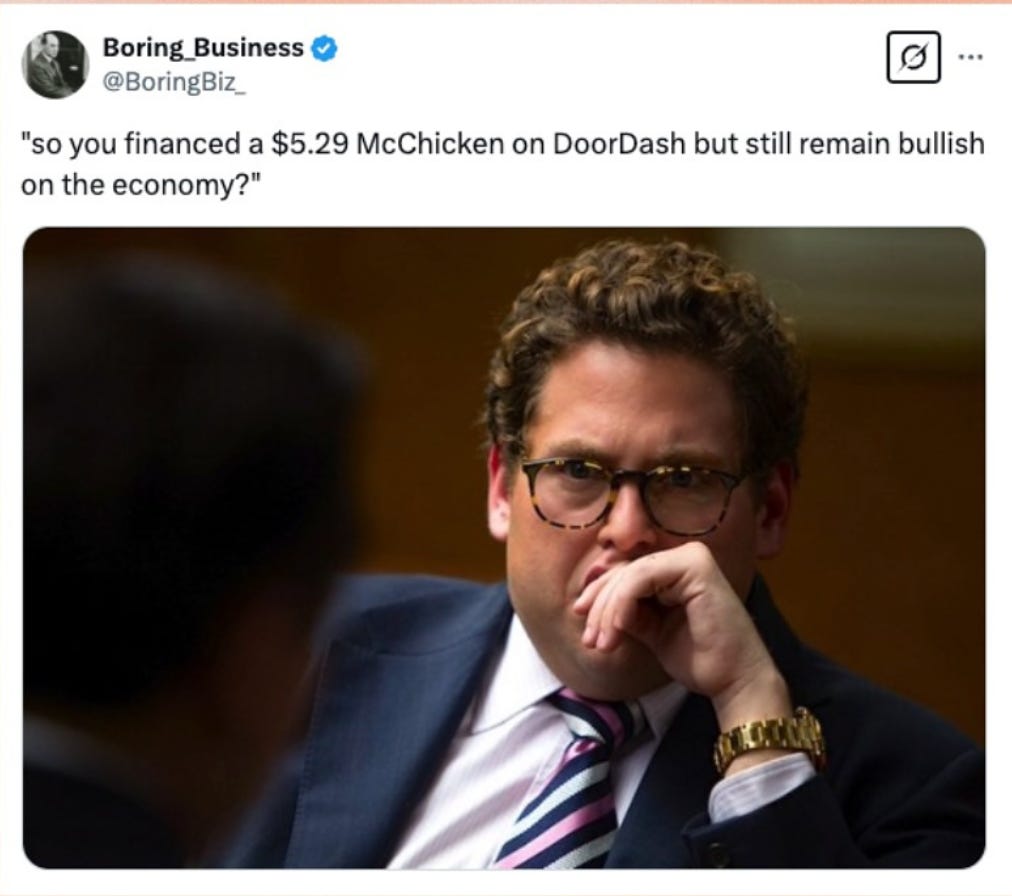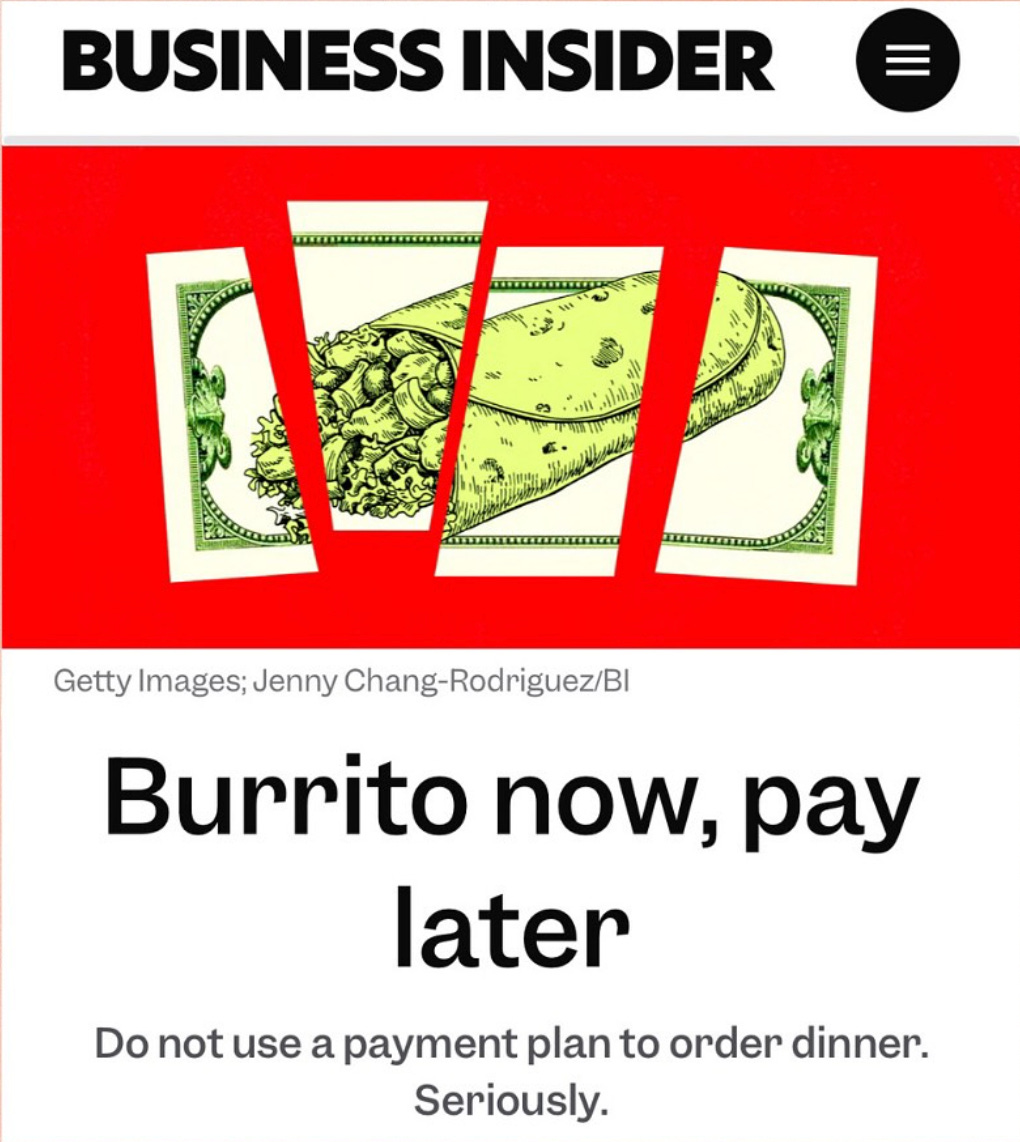‘Eat now, pay later’: DoorDash’s Klarna deal has inspired so many bad takes in personal finance media
Diet culture, meet budget culture: Now we have an efficient way to critique not only what you eat but also how you pay for it!
The personal finance space has been giddy with takes in recent weeks after food delivery app DoorDash announced a partnership with Klarna, a “buy now, pay later” payment processor.
These takes are a disastrous mashup of diet culture and budget culture. Now we have an efficient way to critique not only what you eat but also how you pay for it! When these cultural forces team up, the nonsense of their messaging becomes so plain.
What everyone should hate about buy now, pay later (and what they actually hate)
Klarna, a Swedish fintech founded in 2005 that took off in Europe around 2011, has become increasingly popular with online retailers since turning its focus to the U.S. in 2015. You’ve probably seen the “pay with Klarna” option on many an online checkout page.
Buy now, pay later (BNPL) is an alternative to credit that offers what the name suggests: Make a purchase now, and pay in installments or pay the full bill at a later time. In that way, it’s like using a credit card.
The difference is you don’t have to apply for a card, you don’t get a credit limit and there’s no interest charged on your payments. When you click that “pay with Klarna” (or Affirm or Afterpay) button at checkout, you’re subject to a soft credit check (i.e. it’s not reported to credit bureaus) and approved on the spot for the single purchase. Just like with a credit card, you pay nothing extra as long as you make your payments on time. If you miss payments, you’re charged a fee, and if you miss payments for long enough, the debt can be sent to a collector and reported to credit bureaus.
Only about one in 10 Americans have used BNPL. Those users tend to be “financially fragile,” as one Federal Reserve report describes them: low credit scores, minimal resources, past bankruptcies and high credit card debt. Regardless of financial circumstances, women and Black and Latino folks are more likely to use BNPL than others.
Like any financial product that offers women of color and poor people access to the kind of consumption previously reserved for rich white men, BNPL has faced criticism in personal finance media since its inception.
Some, but not most, of that critique was warranted.
BNPL was shrouded in mystery for a while, like any new fintech. It came with big promises but little explanation about how it worked or the risks to users. Regulation was slow to catch up. That meant, yes, BNPL gave shoppers access to financing they might not otherwise qualify for. But their “responsible” repayment of the loan did nothing to improve their credit scores and help them rely less on the product — until recently, BNPL companies didn’t report borrowing or positive payment history, only delinquent loans. They also started out fast and loose with loan approvals, hungrily accumulating users like any new tech company that doesn’t need to turn a profit. Their lending standards have since tightened, according to the Fed report, and some apps are starting to report positive histories to credit bureaus.
For years, shoppers didn’t have any recourse if, for example, they returned a product and had trouble getting a refund. BNPL loans just didn’t fall under any existing regulation. The Consumer Financial Protection Bureau announced last year that BNPL lenders are now treated like credit card companies, so buyers have the same rights to dispute charges and get refunds as they do with credit card purchases, a huge step forward.
Like payday loans, BNPL loans prey on those financially vulnerable shoppers they attract most. They promise easy money with a lower barrier to entry than a credit card. They position themselves at the point of sale, when shoppers are unlikely to pore over the details of a financial agreement or question the mechanisms of an unfamiliar payment option. They promise “no interest” and “no fees” but charge upwards of 25% in late fees for missed payments.
The biggest critique of BNPL from personal finance media, however, has always been that it’s an “irresponsible” way to shop.
That couldn’t be because it’s so strongly associated with purchases deeply coded as female… could it? Personal finance gurus would never!
Critiquing BNPL as “irresponsible” is a familiar refrain: If you don’t have the cash on hand, you don’t deserve the purchase. If you never have the cash on hand, you simply must not be working hard enough to earn it.
Critics are slamming the DoorDash-Klarna deal for what it seems to say about our debt-dependent economy. They say this kind of business model incentivizes “impulsivity.”
“We love a good vice in the United States, and we can do it completely frictionless,” said economic commentator Kyla Scanlon in a video. “We don’t even have to put on pants. Just app it to you and worry about everything else later.”
This kind of commentary attempts to call out the companies for encouraging bad behavior, but the critique rings hollow. When you talk about “impulse control” and “vices,” the blame ultimately falls on the individual. And the advice from personal finance media never recommends tighter regulation or more equitable distribution of resources. It all lands on the same condescending point: “Do not use a payment plan to order dinner. Seriously.”
Business Insider senior correspondent Emily Stewart says the quiet part out loud: “The concern is that people who use BNPL might buy more even when they shouldn't.”
Stewart comes to her conclusion via a study that links BNPL usage to increased spending for people with limited resources. But of course BNPL is linked with higher spending! When people have more resources, they can buy things they previously didn’t have access to — and BNPL, like a credit card, is a resource. You might be shocked to learn that being rich is linked with higher spending, too.
Yes, you can ‘finance a private taxi for your burrito’
Teaming up with DoorDash to offer small installment loans for food delivery sets up BNPL as an easy target for the laziest of cultural commentators online.
The three most-ordered foods on DoorDash are french fries, quesadillas and mozzarella sticks. (Excuse me, I’m drooling.) While the company loves to tout its relationships with small businesses, fast-food chains make up the bulk of restaurants listed in the app.
DoorDash drivers are delivering exactly the kinds of foods diet culture loves to hate: made of carbs, cooked in fat and smothered in cheese. Food delivery is short on fresh, green, crunchy veggies — the kind of stuff diet culture deems “healthy.”
Commentators are telling on themselves in their critiques. They don’t just think you’re stupid for financing a small purchase — they’re disgusted by your choice of food in the first place.
Attempts at clever critique of the DoorDash-Klarna deal have been focused (so much! so unoriginally!) on Chipotle burritos, with more than one commentary referring to DoorDash as a “burrito taxi.” The implications of laziness, slovenliness and indulgence in those two words are heavy.
Listen: Burritos are delicious, filling, relatively cheap and they travel well.
BNPL lets you eat that meal today and pay for it when it feels like less of a burden for you.
This is not to defend either Klarna or DoorDash as companies. I do not care about these two opportunistic amalgamations of late-capitalist greed. I’m defending the humans who take advantage of the apps to get through at least one more day — to feed their children when they’re stuck at work late, to stay fed between paychecks, to get groceries when a flu is ripping through their household, to enjoy a GD mozzarella stick without putting on a bra.
Shame on personal finance media for making you feel stupid for using this option.
I know it’s not a good option. It’s technocapitalism run amok.
Klarna transparently made this deal to capture more users in the run up to a highly anticipated IPO (which it paused in the wake of Trump’s tariffs, whoops).
As an improperly regulated gig app, DoorDash is a nightmare of worker and consumer exploitation.
Our economy shouldn’t depend on debt; people should have the resources they need and not have to buy them from a few financial companies that hoard them.
And I don’t need to get into what 8,000 documentaries have already told you about the ways fast-food companies harm workers, the environment, food systems, local economies and more.
But, in response to DoorDash’s announcement, all of this totally necessary critique has been ignored in favor of, “Don’t take on more debt, fatty.”
The DoorDash-Klarna deal is a perfect opportunity for budget culture and diet culture to coalesce into one glorious pile of shame and make sure there’s not a single thing about yourself that you like today.
Ignore the critiques.
Buy the food you want, and buy it however you want. Feed yourself. The rest of this does not matter.







While Klarna may be a new high tech version, as a child of a blue collar family in the 70's, much of my school clothes and Christmas presents came to me via Lay-Away services at stores like Bradlee's, Two Guys, Sears, and JC Penney. Back when credit cards were for rich people, this was how to make sure that they things you wanted were still available when you were able to finally pay. And yet this was treated the same as Klara is now, when the fact is, our financial system was designed to help those who have money, and prevent those who don't from joining their ranks.
I'm in retail. I know that when you return an item you've paid for by credit card, it takes a few business days for the credit to hit your account. With BNPL, the customer gets some kind of 'alternate card number', and that's where the credit goes, not to the card the customer uses. I have no idea how long it takes or how they get the credit to their actual card for the amount they've already paid. All I know is that the average customer doesn't understand the process and gets mad at me. It's a mess.